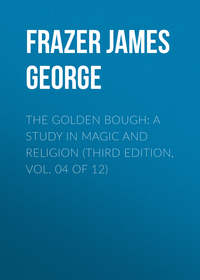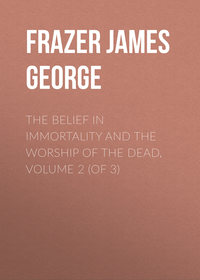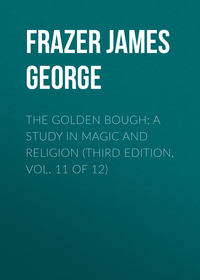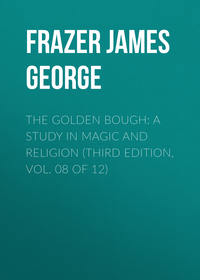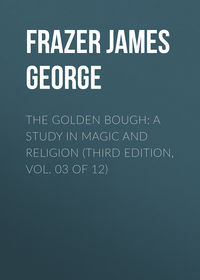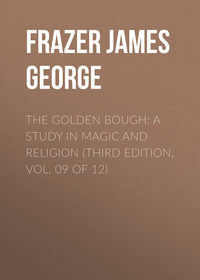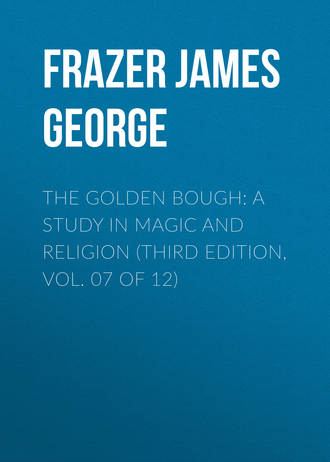
The Golden Bough: A Study in Magic and Religion (Third Edition, Vol. 07 of 12)
1028
A. F. van Spreeuwenberg, “Een blik op de Minahassa,” Tijdschrift voor Neerlands Indië, Vierde Deel (Batavia, 1845), p. 316; J. G. F. Riedel, “De landschappen Holontalo, Limoeto, Bone, Boalemo, en Kattinggola, of Andagile,” Tijdschrift voor Indische Taal- Land- en Volkenkunde, xix. (1869) p. 140; id., in Zeitschrift für Ethnologie, iii. (1871) p. 404.
1029
Spenser St. John, Life in the Forests of the Far East, Second Edition (London, 1863), i. 214. Compare H. Low, Sarawak (London, 1848), p. 251.
1030
Dr. Charles Hose, “Various Modes of computing the Time for Planting among the Races of Borneo,” Journal of the Straits Branch of the Royal Asiatic Society, No. 42 (Singapore, 1905), pp. 1 sq. Compare Charles Brooke, Ten Years in Sarawak (London, 1866), i. 59; Rev. J. Perham, “Sea Dyak Religion,” Journal of the Straits Branch of the Royal Asiatic Society, No. 10 (Singapore, 1883), p. 229.
1031
Dr. Charles Hose, op. cit. p. 4. Compare id., “The Natives of Borneo,” Journal of the Anthropological Institute, xxiii. (1894) pp. 168 sq., where the writer tells us that the Kayans and many other races in Borneo sow the rice when the Pleiades appear just above the horizon at daybreak, though the Kayans more usually determine the time for sowing by observation of the sun. As to the Kayan mode of determining the time for sowing by the length of shadow cast by an upright pole, see also W. Kükenthal, Forschungsreise in den Molukken und in Borneo (Frankfort, 1896), pp. 292 sq. Some Dyaks employ a species of sun-dial for dating the twelve months of the year. See H. E. D. Engelhaard, “Aanteekeningen betreffende de Kindjin Dajaks in het Landschap Baloengan,” Tijdschrift voor Indische Taal- Land- en Volkenkunde, xxxix. (1897) pp. 484-486.
1032
A. W. Nieuwenhuis, Quer durch Borneo (Leyden, 1904-1907), i. 160.
1033
F. K. Ginzel, Handbuch der mathematischen und technischen Chronologie, i. (Leipsic, 1906) p. 424.
1034
R. Friederich, “Voorloopig Verslag van het eiland Bali,” Verhandelingen van het Bataviaasch Genootschap van Kunsten en Wetenschappen, xxiii. (1849) p. 49.
1035
J. T. Nieuwenhuisen en H. C. B. von Rosenberg, “Verslag omtrent het eiland Nias en deszelfs Bewoners,” Verhandelingen van het Bataviaasch Genootschap van Kunsten en Wetenschappen, xxx. (Batavia, 1863) p. 119.
1036
W. Marsden, History of Sumatra, Third Edition (London, 1811), p. 71.
1037
F. K. Ginzel, Handbuch der mathematischen und technischen Chronologie, i. (Leipsic, 1906) p. 428.
1038
S. Krascheninnikow, Beschreibung des Landes Kamtschatka (Lemgo, 1766), p. 217. The three stars are probably the Belt.
1039
See above, vol. i. p. 116.
1040
Rev. J. Macdonald, Light in Africa, Second Edition (London, 1890), pp. 194 sq. Compare J. Sechefo, “The Twelve Lunar Months among the Basuto,” Anthropos, iv. (1909) p. 931.
1041
G. McCall Theal, Records of South-Eastern Africa, vii. (1901) p. 418. Compare G. Thompson, Travels and Adventures in Southern Africa (London, 1827), ii. 359.
1042
Rev. H. Callaway, The Religious System of the Amazulu, Part iii. (London, etc., 1870), p. 397.
1043
R. Moffat, Missionary Labours and Scenes in Southern Africa (London, 1842), pp. 337 sq.
1044
Stephen Kay, Travels and Researches in Caffraria (London, 1833), p. 273.
1045
Gustav Fritsch, Die Eingeborenen Süd-Afrika's (Breslau, 1872). p. 340.
1046
Theophilus Hahn, Tsuni-Goam, the Supreme Being of the Khoi-Khoi (London, 1881), p. 43, quoting the Moravian missionary George Schmidt, who was sent out to the Cape of Good Hope in 1737.
1047
H. S. Stannus, “Notes on some Tribes of British Central Africa,” Journal of the R. Anthropological Institute, xl. (1910) p. 289.
1048
M. Merker, Die Masai (Berlin, 1894), pp. 155, 198.
1049
May.
1050
June-August.
1051
A. C. Hollis, The Masai (Oxford, 1905), p. 275, compare p. 333. The “season of showers” seems to be a name for the dry season (June, July, August), when rain falls only occasionally; it is thus distinguished from the rainy season of winter, which begins after the reappearance of the Pleiades in September.
1052
A. C. Hollis, The Masai, pp. 275 sq.
1053
A. C. Hollis, The Nandi (Oxford, 1909), p. 100.
1054
C. W. Hobley, “Further Researches into Kikuyu and Kamba Religious Beliefs and Customs,” Journal of the Royal Anthropological Institute, xli. (1911) p. 442.
1055
Thomas Winterbottom, An Account of the Native Africans in the Neighbourhood of Sierra Leone (London, 1803), p. 48.
1056
Hesiod, Works and Days, 383 sq., 615 sqq. See above, pp. 45, 48.
1057
Aratus, Phaenomena, 264-267; Pliny, Nat. Hist. ii. 123, 125, xviii. 280, “Vergiliae privatim attinent ad fructus, ut quarum exortu aestas incipiat, occasu hiems, semenstri spatio intra se messes vindemiasque et omnium maturitatem conplexae.” Compare L. Ideler, Handbuch der mathematischen und technischen Chronologie (Berlin, 1825-1826), i. 241 sq. Pliny dated the rising of the Pleiades on the 10th of May and their setting on the 11th of November (Nat. Hist. ii. 123, 125).
1058
Pliny, Nat. Hist. xviii. 49 and 223.
1059
See above, p. 307.
1060
Geminus, Elementa Astronomiae, xvii. 10 sqq. If “the sweet influences of the Pleiades” in the Authorised Version of the English Bible were an exact translation of the corresponding Hebrew words in Job xxxviii. 31, we should naturally explain the “sweet influences” by the belief that the autumnal setting of the constellation is the cause of rain. But the rendering of the words is doubtful; it is not even certain that the constellation referred to is the Pleiades. See the commentaries of A. B. Davidson and Professor A. S. Peak on the passage. The Revised English Version translates the words in question “the cluster of the Pleiades.” Compare H. Grimme, Das israelitische Pfingstfest und der Plejadenkult (Paderborn, 1907), pp. 61 sqq.


